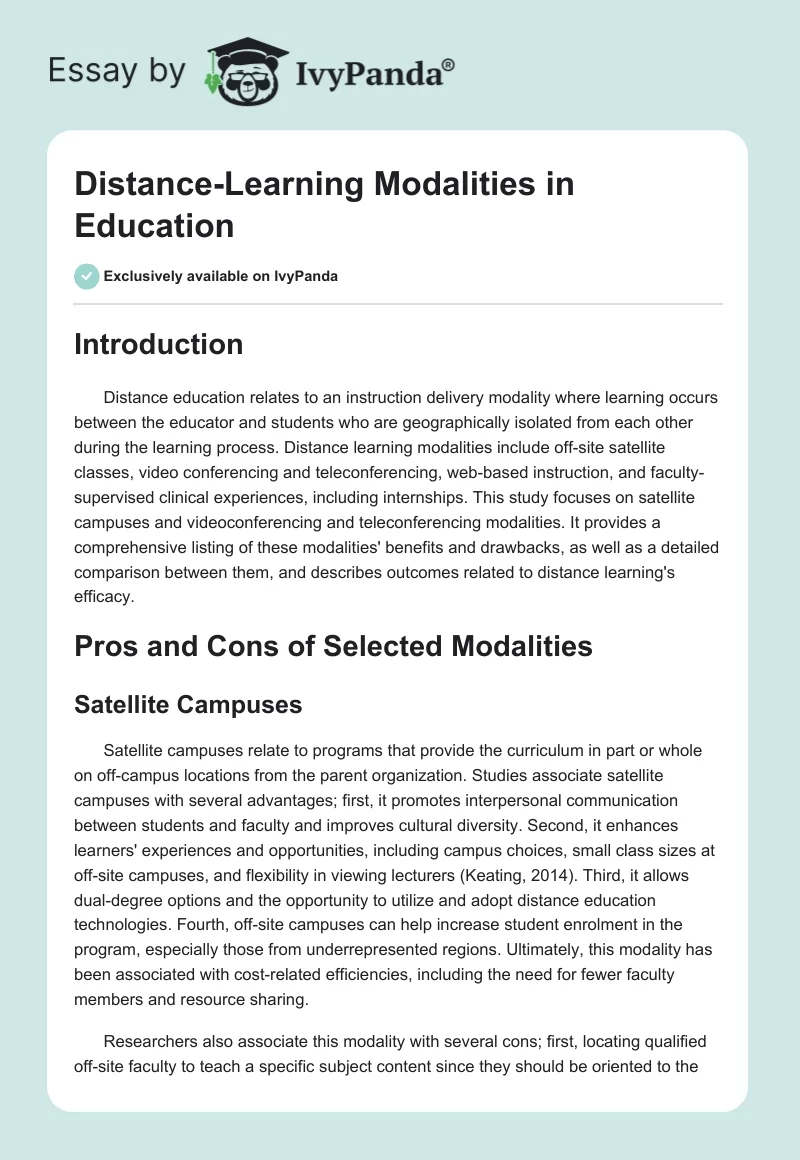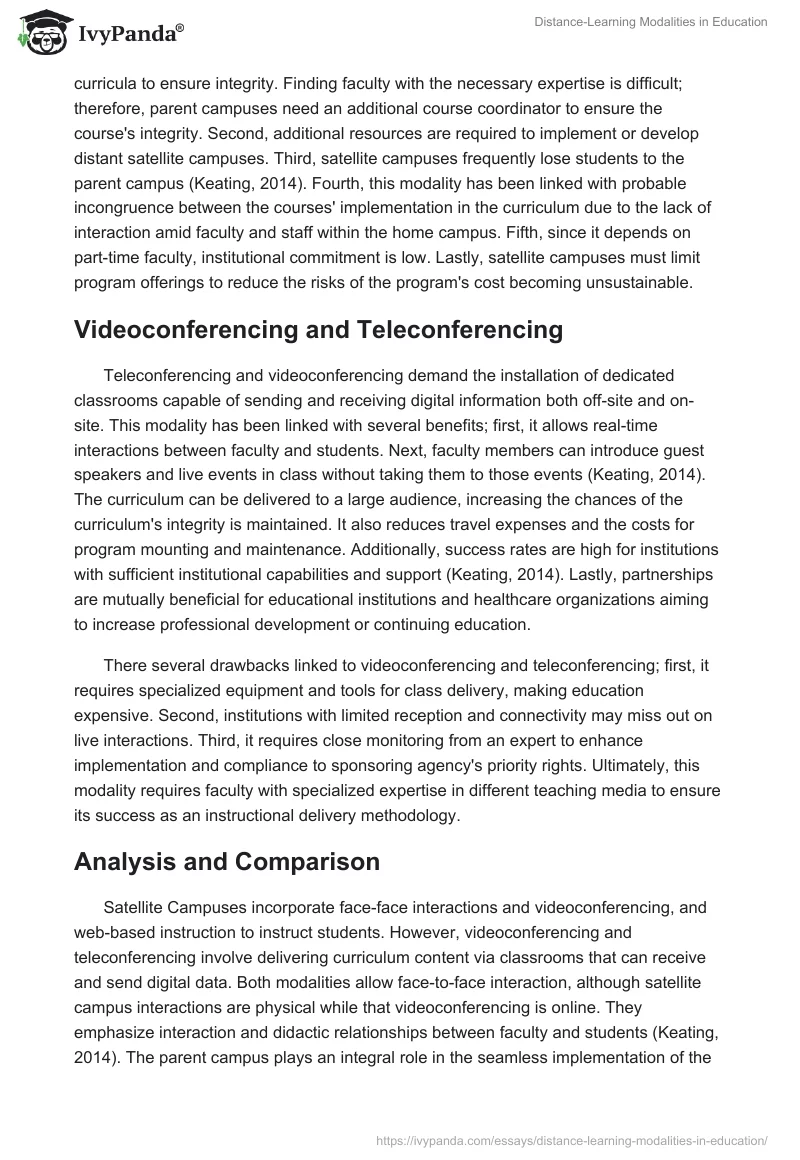Introduction
Distance education relates to an instruction delivery modality where learning occurs between the educator and students who are geographically isolated from each other during the learning process. Distance learning modalities include off-site satellite classes, video conferencing and teleconferencing, web-based instruction, and faculty-supervised clinical experiences, including internships. This study focuses on satellite campuses and videoconferencing and teleconferencing modalities. It provides a comprehensive listing of these modalities’ benefits and drawbacks, as well as a detailed comparison between them, and describes outcomes related to distance learning’s efficacy.
Pros and Cons of Selected Modalities
Satellite Campuses
Satellite campuses relate to programs that provide the curriculum in part or whole on off-campus locations from the parent organization. Studies associate satellite campuses with several advantages; first, it promotes interpersonal communication between students and faculty and improves cultural diversity. Second, it enhances learners’ experiences and opportunities, including campus choices, small class sizes at off-site campuses, and flexibility in viewing lecturers (Keating, 2014). Third, it allows dual-degree options and the opportunity to utilize and adopt distance education technologies. Fourth, off-site campuses can help increase student enrolment in the program, especially those from underrepresented regions. Ultimately, this modality has been associated with cost-related efficiencies, including the need for fewer faculty members and resource sharing.
Researchers also associate this modality with several cons; first, locating qualified off-site faculty to teach a specific subject content since they should be oriented to the curricula to ensure integrity. Finding faculty with the necessary expertise is difficult; therefore, parent campuses need an additional course coordinator to ensure the course’s integrity. Second, additional resources are required to implement or develop distant satellite campuses. Third, satellite campuses frequently lose students to the parent campus (Keating, 2014). Fourth, this modality has been linked with probable incongruence between the courses’ implementation in the curriculum due to the lack of interaction amid faculty and staff within the home campus. Fifth, since it depends on part-time faculty, institutional commitment is low. Lastly, satellite campuses must limit program offerings to reduce the risks of the program’s cost becoming unsustainable.
Videoconferencing and Teleconferencing
Teleconferencing and videoconferencing demand the installation of dedicated classrooms capable of sending and receiving digital information both off-site and on-site. This modality has been linked with several benefits; first, it allows real-time interactions between faculty and students. Next, faculty members can introduce guest speakers and live events in class without taking them to those events (Keating, 2014). The curriculum can be delivered to a large audience, increasing the chances of the curriculum’s integrity is maintained. It also reduces travel expenses and the costs for program mounting and maintenance. Additionally, success rates are high for institutions with sufficient institutional capabilities and support (Keating, 2014). Lastly, partnerships are mutually beneficial for educational institutions and healthcare organizations aiming to increase professional development or continuing education.
There several drawbacks linked to videoconferencing and teleconferencing; first, it requires specialized equipment and tools for class delivery, making education expensive. Second, institutions with limited reception and connectivity may miss out on live interactions. Third, it requires close monitoring from an expert to enhance implementation and compliance to sponsoring agency’s priority rights. Ultimately, this modality requires faculty with specialized expertise in different teaching media to ensure its success as an instructional delivery methodology.
Analysis and Comparison
Satellite Campuses incorporate face-face interactions and videoconferencing, and web-based instruction to instruct students. However, videoconferencing and teleconferencing involve delivering curriculum content via classrooms that can receive and send digital data. Both modalities allow face-to-face interaction, although satellite campus interactions are physical while that videoconferencing is online. They emphasize interaction and didactic relationships between faculty and students (Keating, 2014). The parent campus plays an integral role in the seamless implementation of the program in both modalities. Moreover, in satellite campuses, part of the classes is conducted on-site at the parent campus. Similarly, videoconferencing can also be delivered in on-site classes. Both modalities’ parent campus is responsible for ensuring course integrity and that the curriculum satisfies their educational goals.
Outcome Description Related to Teaching and Learning Effectiveness and Student and Faculty Satisfaction
Distance learning (DL) is associated with positive learning outcomes and student and faculty satisfaction. Berndt et al. (2017) showed that rural health practitioners and class facilitators were highly satisfied with distance learning strategies in professional development. Al-Balas et al. (2020) also supported this notion that distance learning improves learning outcomes. The study showed the approach provides students with educational autonomy and facilitates access to a broader range of learning resources. Another survey by Tomaino et al. (2021) demonstrated that DL produced positive educational outcomes in students with severe developmental and behavioral needs. The study participants showed positive progress in achieving their academic goals when they were engaged in DL. Tomaino et al. (2021) revealed that using audio, video, computers, and the internet increased parental engagement in students’ education. The DL helped the parents assess their children’s academic ability and learn how to effectively manage their disabilities and challenging behaviors with the instructor’s help.
DL is also cost-effective and can lead to cost-savings related to travel time. Rotimi et al. (2017) report that web-based programs make learning cheaper and are viable alternatives to face-to-face classes. Berndt et al. (2017) revealed that DL reduced healthcare providers’ travel time and costs (learners). Therefore, it can be surmised that DL can reduce travel costs for learners. Another aspect that stood out in Berndt et al. (2017) study is that face-to-face learning does not result in better outcomes than DL. The study showed that distance education produces better learning outcomes irrespective of delivery modes (Berndt et al., 2018). Learning outcomes were measured using learners’ knowledge and satisfaction scores.
However, it is essential to note that distance learning does not always result in high satisfaction levels unless certain conditions are fulfilled. Al-Balas et al. (2020) showed that medical students have negative perceptions of distance learning and were unsatisfied with it. The participants’ negative perception and dissatisfaction with distance learning emanated from their past experiences with the program. The students revealed that most distance-learning faculty were uncooperative and generally preferred the traditional approach. This revelation confirms Keating’s (2017) assertion that a critical weakness of distance learning is the lack of faculty commitment. Approximately 55.2% of the students also believed that other medical students would not commit to DL programs (Al-Balas et al., 2020). Satisfaction with DL was strongly connected to student’s experiences and interactions with the program’s faculty. Therefore, institutions should implement strategies to enhance both faculty and students’ reception of the program. On a positive note, 75.5% of the study participants preferred the blended education approach (mix of distance learning and on-site classes) (Al-Balas et al., 2020). This preference should encourage the integration of distance learning modalities with the traditional learning style.
Conclusion
Technological advancements in the education sector allow both learners and faculty members to easily access, collect, evaluate, and disseminate knowledge and relevant data. Learning communities have currently evolved from conventional classrooms to e-learning settings. Students converge or connect in a virtual surrounding to solve issues, exchange ideas, develop new meanings, and explore alternatives. There are various distance learning modalities, including teleconferencing and videoconferencing and satellite campuses. These methodologies have been associated with significant benefits and drawbacks.
References
Al-Balas, M., Al-Balas, H. I., Jaber, H. M., Obeidat, K., Al-Balas, H., Aborajooh, E. A., Al-Taher, R., & Al-Balas, B. (2020). Distance learning in clinical medical education amid COVID-19 pandemic in Jordan: Current situation, challenges, and perspectives. BMC Medical Education, 20, 1–7. Web.
Berndt, A., Murray, C. M., Kennedy, K., Stanley, M. J., & Gilbert-Hunt, S. (2017). Effectiveness of distance learning strategies for continuing professional development (CPD) for rural allied health practitioners: A systematic review. BMC Medical Education, 17, 1–13. Web.
Keating, S. B. (2014). Curriculum development and evaluation in nursing (3rd ed.). Springer Publishing.
Rotimi, O., Orah, N., Shaaban, A., Daramola, A. O., & Abdulkareem, F. B. (2017). Remote teaching of histopathology using scanned slides via skype between the United Kingdom and Nigeria. Archives of Pathology & Laboratory Medicine, 141(2), 298–300. Web.
Tomaino, M. A. E., Greenberg, A. L., Kagawa-Purohit, S. A., Doering, S. A., & Miguel, E. S. (2021). An assessment of the feasibility and effectiveness of distance learning for students with severe developmental disabilities and high behavioral needs. Behavior Analysis in Practice, 1(1), 1–16. Web.


